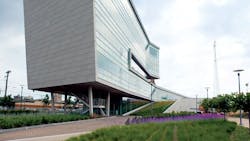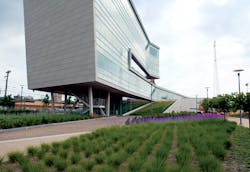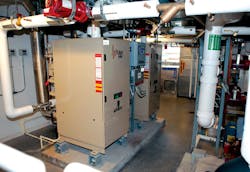Pulse-Combustion Boilers Play Key Role in Sustainability-Lab HVAC
The Syracuse Center of Excellence (SyracuseCoE) in Syracuse, N.Y., serves two important functions: “It’s a lab, researching innovative approaches to clean and renewable energy, indoor environmental quality, and water resources, but it’s also a demonstration space, showcasing existing technologies that support sustainable design,” Martin Walls, SyracuseCoE communications manager, explained.
Built on an industrial brownfield, the five-story, 55,000-sq-ft building incorporates such innovations as a vapor-intrusion system; a stormwater-retention tank; a 150-ft “urban-ecosystem observatory”; demand-controlled ventilation; underfloor ventilation and raised flooring; radiant ceilings; no-water urinals and dual-flush, low-flow toilets and faucets; furniture made from recycled materials and Forest Stewardship Council-certified wood; high-efficiency compact fluorescent and LED lighting controlled with a daylight-harvesting (auto-dimming) system and auto-shutoff occupancy sensors; highly insulated windows with integrated electronically controlled blinds; and a roof designed to reflect most sunlight and allow future installation of photovoltaics, building-scale wind turbines, and rooftop HVAC units.
The building’s geothermal system uses more than five miles of tubing installed in 49 300-ft-deep wells to circulate water and exchange heat with the ground, achieving energy savings of 35 percent when compared with traditional heating and cooling systems. The ground’s constant temperature of 53°F helps to heat the building during winter and cool it during summer, meeting 40 percent of the center’s heating and cooling needs throughout the year.
When the geothermal system requires supplemental heat, two Fulton Pulse hydronic condensing boilers provide additional energy. The boilers also provide heat for domestic hot water.
SyracuseCoE “is using the Pulse boiler because the boiler is so efficient,” Dan Brosnan, sales engineer for Comfort Systems Inc. of Syracuse, the company that supplied the boilers, said. “It has a small footprint and a fairly robust design without limits for flow rate and return-water temperature, making it the perfect boiler for this type of application, where water temperatures range from a low of 28°F to a high of 90°F.
“A conventional boiler would require a secondary loop so that the boiler would never see such low temperatures,” Brosnan continued, “but with the Fulton boiler, you can actually run those low temperatures through the boiler without fear of hurting the life expectancy of the boiler.”
Walls added: “It’s this low-temperature capability and the boiler’s efficiency that made the Fulton Pulse boiler our boiler of choice.”
Pulse-combustion technology is widely recognized as one of the most efficient ways to burn fuel. A pulse is defined as one cycle of ignition and combustion of a gas/air mixture in a specially designed chamber.
Because the pulse-combustion process is naturally aspirated and does not require a blower motor for operation, Pulse boilers reduce electrical consumption. An assist fan is used for pre- and post-purge only and turns off once combustion is established. Pulse boilers require electricity only for purge cycles, powering fuel valves, control, and other safety features. The pulse-combustion process itself does not require electricity.
“We’re not burning any electricity to put air into the boiler because the pulse process pulls the air in using the laws of physics, as opposed to a fan,” Brosnan said. “And because there aren’t any moving parts when the boiler is operating, other than the modulation gas control, the boiler requires less maintenance, and the costs associated with maintenance are considerably lower.”
A Synex Controls ModSync sequencing system optimizes the operation of the boilers to limit the number of cycles and maximize efficiency.
“Conventional boilers and control systems bring a boiler on, and once the boiler is operating on its highest firing rate, the control system brings on the second boiler,” Brosnan explained. “Using Fulton condensing boilers, the first boiler is brought on, and once it reaches about 50-percent firing rate, the ModSync brings the second boiler on. Then, both boilers drop to the appropriate firing rate and operate together.”
A Synex Controls inSite remote monitoring system is used to monitor the boilers.
“The inSite monitoring system notifies facility operators through their cellphones of any problems with the boilers,” Brosnan said. “In addition, an application provides information about setpoints, alarms, etc., which is especially important in a facility like this one that is not occupied 24/7.”
InSite was designed to interface directly with ModSync for remote monitoring and system access using any traditional Web browser. There is no software to install or licensing fees to pay.
The boilers are viewed as an important part of SyracuseCoE’s success.
“We give many tours of this facility, and the boilers are included in the tour,” Walls said. “We have windows in the boiler room so that visitors can see the boilers, and we offer explanations as to how they operate to help heat the building.
“The energy efficiency the boilers provide is worth noting,” Walls concluded.
For Design Solutions author guidelines, call Scott Arnold, executive editor, at 216-931-9980, or write to him at [email protected].


